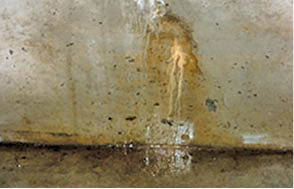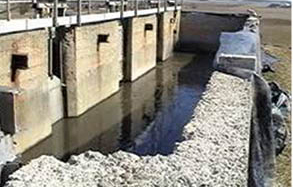The Structures – The Problems
Xypex products play a key role in the waterproofing and protection of concrete against water penetration due to hydrostatic pressure, and aggressive chemical attack – problems typically associated with the reduced service life of concrete industrial structures.
Chemical Attack
Industrial concrete structures are subject to attack from a variety of chemicals whether they be acidic or alkaline, organic or inorganic, man-made or natural. Amongst the many chemicals which attack concrete are acids (sulphuric, formic, lactic, acetic, carbonic, acid mine drainage), chlorides, sulphates, nitrates, and petrochemicals. Concrete may also be damaged during the manufacturing or waste treatment processes. The diffusion of these chemicals through porous concrete can cause problems such as corrosion of the reinforcing steel, cracking, and spalling of the concrete.
Ground Water
A priority in the waterproofing of concrete industrial structures is the prevention of water ingress due to hydrostatic pressure from the surrounding water table. Both on-grade and below grade structures must be protected against water damage and corrosion of the reinforcing steel. The nature of concrete and the problems associated with placement and consolidation means having to deal with permeability issues permitting the penetration of water into the substrate and through to the reinforcing steel. With the presence of oxygen this can initiate corrosion.

Wastewater Treatment
Industrial wastewater can contain everything from sediments to hormones to acids and is often damaging to the concrete structures involved in its treatment. Whether it is the removal of solids and sediment, oil and grease, or other chemicals, concrete used in wastewater treatment is exposed to a number of harsh elements that greatly increase the probability of cracking, spalling and corrosion. Concrete exposed to industrial wastewater may be subject to Microbial Induced Corrosion as a result of the production of Hydrogen Sulphide. Additionally, solids and sediment may damage the concrete through abrasion.

Containment
Concrete in industry is often used in a variety of primary and secondary containment settings, in which tanks, channels, water treatment structures, cooling tower basins and additional supporting structures must be protected from water ingress due to hydrostatic pressure, and chemical attack. The protection of the concrete is important for several reasons: Not only must the concrete be protected in order to maintain its structural integrity and to avoid costly rehabilitation, but it must also protect the surrounding environment from leaks. The constant loss of any liquid also causes significant increases in the operating cost of industrial facilities.
Additional Problems
- Cracking
- Carbonation
- Freeze/Thaw
- Alkali Aggregate Reaction
- Surface Deterioration (Abrasion)